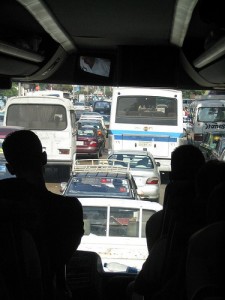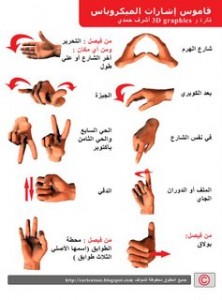This post is part of our special coverage Languages and the Internet
We as humans have a unique ability to communicate via spoken languages. However, in a crowded and loud city like Cairo, we sometimes need more than a spoken language to communicate.
Lyndall EL Masry, an expatriate living in Cairo, noticed that people who use shared taxi micro-buses use certain hand signals to communicate the locations they want to go to:
I find the micro and local buses a bit daunting sometimes – the loud and fast Arabic – the hand signals that have a meaning for a particular destinations.
Those hand signals make it easier to communicate between the drivers and those who are waiting for the micro-bus from a far distance in noisy streets. Ashraf Hamdy – an Egyptian caricaturist – tried to document those hand signals and their meanings in his blog. Here is an image to explain the various hand signals:
In fact, the use of sign language is common in hearing communities wherever speech is not practical or permitted, such as among scuba divers, or footballers, and in television recording studios and stock exchange markets. It's also clear for those who speak Arabic that the above hand signals used in Egyptian streets are more like a mime compared to the linguistics of more complex sign languages, whereas signs have a visual relationship to what they refer to.
The use of car horns
Another form of communication – but it's an audible one this time – is the use of car horns. Dr_ElSioufy wrote a post [ar] in an online forum about those forms of communication. He said:
He then continued to describe each part of the car and its own vocabulary.
شارة يمين مرتين ورا بعض ومرتين شمال يعني ان الي ماشي ادامك بيقول لك اطفي النور العالي خصوصا علي الصحراوي
إشارة يمين ثم إشارة شمال تعني أن هناك من «يشتمك».
الكلاكــــــــــس :
ضغطتان متتاليتان بالكلاكس كل واحدة منفصلة معناها شكرا
.علي الصحراوي لو فاديت ترلة وكلكستلوا معني كدة انك بتحييه وهو لو عنده دم او صاحي مش نايم هيكلكسلك.
ضغطتان بالكلاكس كل واحدة منفصلة عن الأخري، وتتبعهما ضغطة طويلة تعني في لغة السيارات الجديدة بحبك.
استخدام الكلاكسات بطريقة ثلاث ضغطات متتالية يتتبعها ضغطة طويلة تعني «الشتيمة» تاتاتا تااااااته.
المساحات الخلفيه :
لو بتشد مع واحد و عديته تشغل المساحه الخلفيه , معناها باي باي
The right signal twice then the left signal twice means that the car in front of you wants you to switch off the high-beam and use low-beam forward illumination instead, especially when on a highway.
The right signal once then the left signal once is a swear [middle finger]
Car horn:
Two consecutive and separate beeps mean thank you.
When passing a truck on highway you beep to salute him, and he should beep back to you if he's not asleep.
Two consecutive and separate beeps followed by one long beep means in new-car-language “I love you”.
Three consecutive and separate beeps followed by one long beep is a swear word, beep beep beep beeeep [Son of a bitch]
Rear wipers:
When you are racing with someone, and passed him, use the rear wipers to wave him good bye!
I thought the use of car horns for communication is an Egyptian thing, until I read about the students in UC San Diego’s Cognitive Science Department who wrote about the presence of the same phenomenon in India too on their blog, where they wonder whether there are any studies about this.
In my recent trip to India I noticed extremely liberal use of the car horn from my own driver and everyone else on the road. Unlike in the United States, the horn was not used in anger or frustration but as a form of communication. There might be a good opportunity to study the linguistics of this single sound communication. Any thoughts on what kind of study should be done? What else could a study of car horn use inform about human cognition? Let us know in the comments!
Gary Runn also compared the culture of horn honking in the United States, Italy and India. The Jamaicans too have their own car horn honking language with its own set of vocabulary. Such form of communication can be linked to smoke signals and drums used by our ancestors thousands of years ago. And since we use car horns for communication, isn't it possible that they should reflect their owners’ personality too? BBC published an article about research claiming that car horns sound is another big factor in car buyers decision.
Prof Van Leeuwen, an expert in the semiotics of sound at the university's Centre for Language and Communication, said manufacturers were paying more attention to the sound of the horn, which can be a deciding factor for potential car buyers. He argued that more car companies were matching the sound of the horn to the “personality” of the car.
Finally, isn't it interesting that no matter how advanced the means of communications we have nowadays are, we sometimes revert to ancient forms of communication? The following SMS sent between lovers [ar] summarizes the fact that even when having a mobile phone in our hands we might sometimes choose to use it the ancient way for economical reasons.
This post is part of our special coverage Languages and the Internet
The one in the top right corner says “Pyramids Street” (you can notice the pyramid shape there), moving down you will find the second sign saying by the end of the bridge, then the following one says same street, then the fourth one down says next U-turn, and the one at the bottom says from Faissal to Boulack.
The first one on top of the left column has different meanings depending on where you are, so if in Faissal it says Tahrir, while if anywhere else it says straight forward or down the same street. The one after it says Giza, then the third one down says seventh and eighth district (the signs resembles the numbers seven and eight in Arabic respectively). The fourth one says Dokki (a district in Cairo, whose name sounds like the word hammering or knocking in Arabic, that's why the sign), and finally the one on the bottom refers to an area called El Tawabeq (The Levels, and was originally known as The 3 Levels).









2 comments
A7la ta7eya.
Tat tat. Tat tat
This is thank you in a car horn style